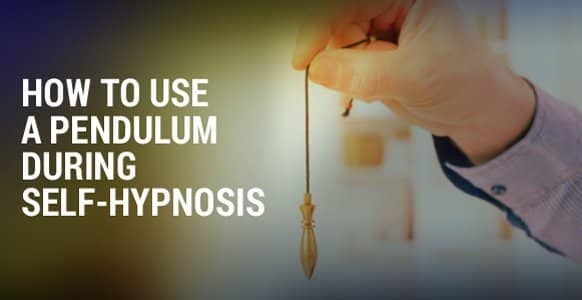
“Allow yourself to see what you don’t allow yourself to see.” – Milton Erickson
In theory, self-hypnosis sounds like a pretty easy task: Simply sit with your eyes closed, relax, connect with your breath and guide your thoughts towards a specific intention.
However, in reality, it can be much more challenging than this very basic instruction. This is because the conscious mind often has another agenda. One that involves distracting you with a million thoughts so you’re unable to truly connect with that all-important unconscious mind.
So when this inevitably happens (especially when you’re starting out), it’s important to find a way to bypass the critical factor (aka, the conscious mind) so you can get to “work.”
And one of the most effective (and easiest) ways to do this is to use a pendulum.
The History Of The Pendulum
People first started using the pendulum for water dowsing in Europe back at the turn of the 19th century.
But it wasn’t until a Frenchman by the name of Michel Eugene Chevreul started experimenting with it that he realized there was more to it than meets the eye.
What he found was that the pendulum had no magical properties on its own. Although, rather interestingly, it did give an ideodynamic response when interacting with the unconscious mind, causing it to move when it receives a signal.
In other words, when the unconscious mind expects something to happen, it gives little micro-muscular twitches that cause the pendulum to move one way or another.
While these signals are very subtle, they can easily be read using a pendulum, helping you to communicate with your unconscious mind.
How To Make A Pendulum
If you have a pendant and a necklace, you can easily use these as your pendulum. But if you don’t, you can make one by simply tying a bolt or nut onto a piece of thread.
Regardless of whether you buy a pendulum or make one, it’s a good idea to carry it around for a few days so it attunes with your energy.
Using The Pendulum
Step 1: Familiarize Yourself With Your Pendulum
Hold the pendulum loosely between your thumb and index finger. Make sure your elbow is free floating, and not resting on a table or locked in place.
Stay relaxed and loose, and start familiarizing yourself with the feel of your pendulum.
Start by swinging your pendulum, making large swings and then smaller swings. Notice how it feels in your wrist, arm and fingertips when it swings.
Once you become familiar with the weight and the feel, you can then begin practicing using it as a tool to communicate with the unconscious mind.
Step 2: Clear Your Mind
Start by connecting with your breath by doing some simple breathing exercises (like you normally would do during self-hypnosis or meditation).
Step 3: Imagine The Pendulum Moving
“Tell” the pendulum to start moving backwards and forward.
Keep repeating this command, and then start telling it to swing in different directions, for example, clockwise, counter-clockwise, or back and forth and side-to-side.
Once it starts to move on your request, you can also start to ask it direct questions that have an obvious answer; depending on which way the pendulum swings, you’ll know what a “yes” or “no” answer is.
Types of questions you can ask include:
- “Is my name… ?”
- “Is my age… ?”
- “Is my profession… ?”
- “Do I live in…?”
Typically the pendulum will swing forward and backward for a “yes” response, and side-to-side for a “no” – however, your experience may be different.
It’s a good idea to always calibrate your pendulum so you know what a “yes” versus a “no” response looks like.
The Five Unconscious Answers
The next step is to have different swings for the Five Unconscious Answers. These answers will help you get further clarity when you ask a question.
The Five Unconscious Answers include:
- Yes
- No
- Please rephrase the question
- I don’t want to answer that
- I don’t know
It might take some time to get clear responses to each of these, but keep commanding your pendulum to show you responses until you’re confident with your signaling system.
Once you’re happy with the above, start asking your pendulum some “truth” questions.
For example:
- Are you going to give me the absolute truth to the questions I ask now and in the future?
Asking these kinds of questions is important as you’ll always want to make sure your unconscious mind is committed to giving you the truth before you start any serious work.
Note: Every time you work with your pendulum, it’s important to reset it or calibrate it with those “yes” or “no” questions and with the Five Unconscious Answers.
Getting To The Root Of The Problem
Using a pendulum during self-hypnosis is especially useful when you need to get to the root of a particular problem.
For example, let’s say you have to give a speech and you feel nervous about standing in front of a large group of people – and your regular self-hypnosis practice isn’t working.
To help you dig a little deeper so you can solve this problem, ask your pendulum a series of questions relating to the issue. For example:
- Did this issue begin when I was a child?
- Was I younger than 18?
- Was I younger than 12?
- Did this issue stem from one incident?
- Did this incident occur while I was in school?
- Did this incident occur some other time?
The trick here is to keep drilling down until you get to the root cause of the issue. This may take as little as 10 minutes, or as long as a few days of regular practice.
When you discover the root cause, you can then create self-hypnosis suggestions to counteract it – commiting to a 21-day process to give your mind time to work through the issue.
Additional Tips:
- Keep a record of your questions
- Prepare questions ahead of time
- Learn from past questions
- Work with your pendulum for a few minutes each day
- Never loan your pendulum out or borrow someone else’s (it’s important it stays attuned to your energy only)
- Have fun with it!
Therefore, just as Michel Eugene Chevreul discovered, the pendulum is a very powerful tool that can be used to connect with your unconscious mind and help you solve problems. So why not give it a go to see how it can deepen your self-hypnosis practice.
Ready to Go Deeper?
With this FREE audio mind training, you’ll be guided into a deep hypnotic state focused on achieving your goals, letting go of unwanted habits, reducing stress, and much more.
It’s the perfect companion to your pendulum work: just press play, relax, and let your unconscious mind take the lead.











![[ADVANCED GUIDE] How To Master Hypnotic Regression Therapy - Part I: Essential Principles To Profoundly Transform Your Subject’s Emotional Trauma [ADVANCED GUIDE] How To Master Hypnotic Regression Therapy - Part I: Essential Principles To Profoundly Transform Your Subject’s Emotional Trauma](https://hypnosistrainingacademy.com/wp-content/uploads/2016/09/hypnotic-regression-therapy-essential-principles.jpg)



